Art of the Genre: An Interview with Matthew D. Wilson
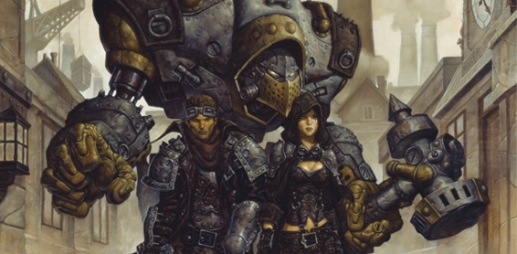 Once again I get a chance show you all the inner workings of the Black Gate LA offices. Yep, it’s always about living the dream, so I hope you enjoy the view.
Once again I get a chance show you all the inner workings of the Black Gate LA offices. Yep, it’s always about living the dream, so I hope you enjoy the view.
After having finally convinced my secretary, Kandline, that cosplaying an elf wasn’t required when she challenged me to afternoon games of Conquest of Nerath, I sat back in my chair and watched a trio of surfers try to catch some rather pathetic waves rolling in along our bit of the Redondo beachfront. From across the hall I could hear Ryan Harvey spouting copious amounts of venom toward Peter Jackson and his newest release of dwarf images for the upcoming Hobbit adaptation, something along the lines of ‘Rankin and Bass will be rolling over in their graves about now!’ a consistent theme.
Enter the dreaded buzz from the front desk. Yep, John O’Neill was at it again, this time his rather brief list of demands of the west coast offices ending in my traveling up the 405 to Santa Monica for an interview with Privateer Press Creative Director Matt Wilson.
Now if you know one certain fact about Matt, it’s that he’s a kind of workaholic. I dig that about him, and while he’s no longer in the Pacific Northwest exclusively doing Privateer work, his mind is ever pushing for bigger and better things at that gaming company.
He wanted to meet me at Sugar Fish, arguably the best sushi bar in all of the L.A. area, and I gladly agreed. With each of us ordering up a ‘Trust Me’, our conversation went full bore as we delighted ourselves on the raw cuisine. We discussed his current Hollywood projects like the already released Wolfsbane, and his newest work that is so super secret I can’t even talk about it other than to say it’s a feature film!
You know, the more I get to talk with Matt, the more I like him, and after this latest encounter, I hope he feels the same. Anyway, once we had a moment to relax, we got into the meat of the interview, so for all you gaming fans out there, I hope you enjoy!
An Interview With Matthew D. Wilson
Conducted and transcribed by Scott Taylor, Late June 2011
.
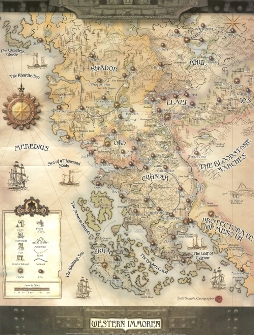
BG: Ok, Iron Kingdoms is an RPG, but you’re an artist as well as the founder of a company that now mainly deals in outstanding miniatures. Do you play RPGs?
MW: I played a lot of RPGs back when I was a gamer, which was before I started making game professionally. In my life, I’ve never been able to balance the two very well; I could either make games, or play them, but for some reason couldn’t figure out how to do both. Truth be told, I like making games more than playing them, and I LOVE playing games. But even with my first exposure to RPGs when I was about 12 years old, I started redesigning them.
I’ve told this story before, but maybe it’ll be new to some people reading this interview. I grew up in a tiny, tiny shithole of a town in northern California; no comic store, no movie theater and no game store. A friend had a collection of the first edition AD&D books — not the originals, but the ones with the Easley covers. Back before this new fangled internet, I had no way of getting my own copies of these books, and this is before photo-copiers were a ubiquitous piece of technology. So I spent several weekends transcribing the rules, charts and tables from those books into a three ring binder full of lined paper; yes, by hand. I copied the books by hand. I couldn’t stand the idea of not having full access to that information, so my only recourse was to do it the old fashioned way…as in, ‘before they had printing presses old fashioned way’. And somewhere in that exercise, I began to develop a deeper love and understanding of game mechanics. By the time I was done, I was already inventing new classes, races, and modifying rules.
It wasn’t too long after that when I started creating my own RPG systems and worlds. I think I completed my first by the time I was 14. I’d done a dozen different worlds and systems by the time I was 20. I think I actually ran more games with my own systems than I did with any off the shelf. Not to say I didn’t have a shelf full of them! I bought everything. I love diving into new worlds and absorbing all of that info. I think my brain was always just inspired by trying to connect the mechanics with the fiction in new and unique ways.
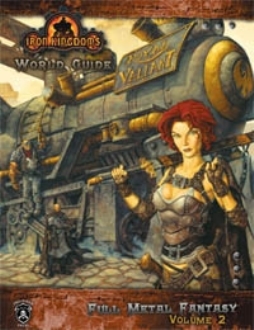 What’s interesting is that for all the RPG playing and creating I did, I have yet to publish one of my own RPG systems; card games, board games, miniatures games — check. No RPG.
What’s interesting is that for all the RPG playing and creating I did, I have yet to publish one of my own RPG systems; card games, board games, miniatures games — check. No RPG.
BG: Train or Steamboat, you make the call and why?
MW: That’s a tough one, Scott. Do I really have to choose? I love trains. All boys love trains. The metal, the sound, the power! I had my first model train set at about 5 years old, and that’s probably what sparked my desire in minis games because I loved the terrain. To me, there is something extremely alluring about a train. Steamboats, though, have their own romance. Arguably, there is a little more freedom of travel with a steamboat, though if you’re on a river it’s still not much more flexible that a train track. And of course, being a pirate at heart, there’s nothing like the swaying deck of a sturdy ship beneath your feet. I’m not generally indecisive, but I’m going to take the easy way out on this one and say I can’t choose: I’m equally comfortable and enchanted by both.
BG: I’m assuming that somewhere/sometime, in your head, the entrepreneur said ‘You know, you can make a company on your own’. Can we hear about this moment, and how Iron Kingdoms came about?
MW: My first true business venture was actually a comic book company. Unfortunately it didn’t go as well as Privateer has done. I’ve always been an entrepreneur. I was the kid with the lemonade stand. When I was 5, I started writing a novel. Any time I could get away with it in school, I made comics. When I was about 15, I was pretty sure I had a way to market rats as a desirable pet — they’re compact, smart, loyal. Seeing how many people are carrying tiny dogs around in their bags, I don’t think I was that far off! So making things for public consumption has always appealed to me. After tanking with the comics though, I was a little gun shy about starting anything new up; the scars from that experience were still a little too fresh. But things change, and I took the plunge with Privateer Press when we published our first D20 books. Even then, there wasn’t an intentional plan to build a big game company, it was really more about just making a few cool books. The plan came later once we realized what we had done and the chord we struck with our audience. The better the response was, the more we wanted to keep making stuff, which is really what has always motivated me; creating things that people enjoy. I’m not much of a fine artist and I haven’t ever painted for myself, for example. I really like doing things that entertain and bring enjoyment to other people. And it’s a great way to make a living.
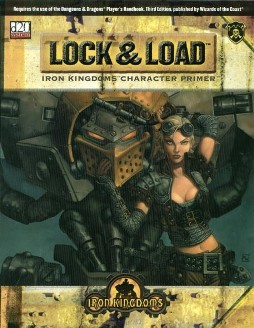 BG: I like to call this genre ‘FantasyPunk’, some steam, some magic. How would you describe it?
BG: I like to call this genre ‘FantasyPunk’, some steam, some magic. How would you describe it?
MW: I dubbed our world, ‘Full Metal Fantasy™’, many years ago. Yes, we own that! To me, Steampunk, which we share a lot of common elements with, needs that Victorian influence, which we don’t have too much of in the Iron Kingdoms. I think ‘Fantasy Punk’ is a good assessment of it, but I also think the word ‘Punk’ gets tacked onto a lot of things without consideration of the actual material. ‘Punk’ carries with it an anti-establishment theme, which is entirely appropriate in say, Cyberpunk. I don’t see it being as relevant in most Steampunk settings that I’ve seen, and it’s definitely not a motif in the Iron Kingdoms. But what is prevalent in the IK is metal. Lots of it. I think there’s a little nod to the musical genre as well, which the IK is certainly textured with. But of course, the most significant reference is to the warjacks — our steam powered robots, which more or less define the Iron Kingdoms setting. These are creations of both technology and magic, the union of which inspired the term, ‘Full Metal Fantasy’.
BG: You did the covers for the Player’s Guide, World Guide, and Witchfire Collection. What was your medium used in these insanely awesome covers?
MW: Those were all painted in oil on boards. The IK Character Guide and the IK World Guide are actually some pretty big pieces, as well — nearly 4 ft. wide, done as wraparound covers. They were each massive endeavors, but are a couple of my favorite personal works to date.
BG: The piece you created for Black Gate’s Art Evolution was digital, and you seemed pretty excited about using some new tech on it. If oil was your foundation, how did digital come into your life?
MW: As an illustrator, I’ve worked with a lot of different mediums. I’m not a very patient person, though, so looking for new ways to get the work done faster has always appealed to me. Working digitally with today’s technology has obvious speed and productivity benefits, so naturally this is something that I have explored along the way. I do love doing artwork, don’t get me wrong. And that’s why painting in oil is always my preference, but as someone who doesn’t work very quickly, oil is quite a time commitment. Working digitally lets me sit down and get into the work much more quickly. The piece I did for your article was done on a Cintiq WACOM tablet, where you can draw with the stylus right on the screen. I love using it because it’s very close to just drawing on paper, but with all those amazing digital tools at your disposal.
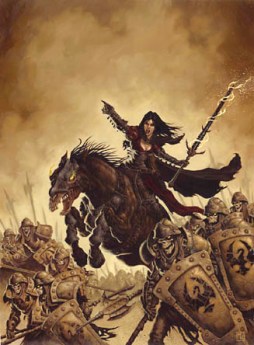 Back when I was art directing Magic: the Gathering, 15 years ago, I was one of the first art directors to embrace digital art from some of the artists that were pioneering it in fantasy illustration back then. It was a battle! Now days, most everything you see is being done digitally. Before the computers and tools became robust enough to really create digital art exclusively, I experimented with a lot of hybrid work. I’d do a drawing, scan it and block in my local color on the computer, print it out in color and mount that on a board, then paint over the print out in detail. All in all, it was a lazy way to work and I would say not my finest hour, but it was fast!
Back when I was art directing Magic: the Gathering, 15 years ago, I was one of the first art directors to embrace digital art from some of the artists that were pioneering it in fantasy illustration back then. It was a battle! Now days, most everything you see is being done digitally. Before the computers and tools became robust enough to really create digital art exclusively, I experimented with a lot of hybrid work. I’d do a drawing, scan it and block in my local color on the computer, print it out in color and mount that on a board, then paint over the print out in detail. All in all, it was a lazy way to work and I would say not my finest hour, but it was fast!
BG: Can you pick an NPC found in Iron Kingdoms and tell us why they’re your favorite.
MW: Why do I have to pick favorites?! I love all my children equally. Really, we have so many characters I can’t even begin to narrow it down to just one. I’ve been living and growing with these characters for a decade now and they’ve really become part of my life. Alexia, the pivotal character around which the WITCHFIRE Trilogy is centered, will always be a favorite — she was the first and I think she is also very unique, becoming a fantasy heroine that gained a great deal of popularity despite being fully clothed. She’s also batshit crazy, which I find utterly entertaining as a character. The warcaster and warlock characters found in WARMACHINE and HORDES are also just too much fun to single any out and say they’re favorites. I think maybe it’s easier as a player, but as a creator, so much love goes into them that picking my absolute favorite is impossible. They’re all heroic, flawed, colorful, and have distinct personalities. I love Stryker’s internally tragic rise, fall and redemption. I love Caine’s renegade attitude. Sorscha’s emotional battle between love and duty is captivating. And Asphyxious has become one of my favorite villains of all time. These characters have taken on a life of their own beyond whatever I gave them as other artists, writers, sculptors, video game designers, etc. have added their vision and expanded their legacy. It’s fun to watch your children grow up; it’s hard to pick a favorite.
BG: What’s with the big gun cartridges? Were they a product of a writer’s tech study or the art department’s need to make things look cool?
MW: Ha! Well, the Iron Kingdoms is a place where the rule ‘bigger is better’ holds fast and true. Big guns need big cartridges, otherwise the ammunition just falls out of the barrel. Makes sense, right?
BG: You plotted the Witchfire trilogy. Can you tell us a bit about that?
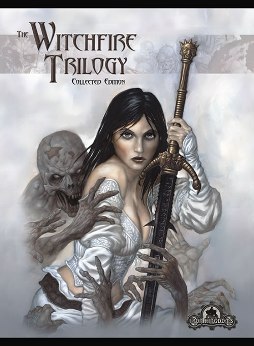 MW: When we started the WITCHFIRE trilogy, we were underway with the art and story before author Matt Staroscik came on board, joined later in the third book by Doug Seacat. In addition to painting the cover and penciling much of the interior artwork, I did the initial world building and created the cast of characters for the story. For Alexia, I defined her character arc, which is an uncommon sort of thing to do in an RPG. Generally, NPCs are fairly static personalities, but I think what has intrigued players of the WITCHFIRE Trilogy for so long is that Alexia becomes a main character involved in the story and she changes over time. From the point that the PCs first encounter her to the end of this epic saga, we see her go through a lot of metamorphosis and it’s very deep, emotional stuff that we can all identify with. It was a very cinematic approach to creating what is otherwise a series of D&D adventure modules, and it was this format and the plot and character development that I brought to the books.
MW: When we started the WITCHFIRE trilogy, we were underway with the art and story before author Matt Staroscik came on board, joined later in the third book by Doug Seacat. In addition to painting the cover and penciling much of the interior artwork, I did the initial world building and created the cast of characters for the story. For Alexia, I defined her character arc, which is an uncommon sort of thing to do in an RPG. Generally, NPCs are fairly static personalities, but I think what has intrigued players of the WITCHFIRE Trilogy for so long is that Alexia becomes a main character involved in the story and she changes over time. From the point that the PCs first encounter her to the end of this epic saga, we see her go through a lot of metamorphosis and it’s very deep, emotional stuff that we can all identify with. It was a very cinematic approach to creating what is otherwise a series of D&D adventure modules, and it was this format and the plot and character development that I brought to the books.
BG: The seemingly final supplement for the Iron Kingdoms RPG was Five Fingers: Port of Deceit, which I was honestly very surprised came out at all considering the market’s move away from the OGL for D20. For all intents and purpose, have physical additions to Iron Kingdoms ceased?
MW: Yes and no. Physical additions to the D20 version of the IK have ceased. However, at our first annual Privateer Press event, the LOCK & LOAD GAMEFEST, held in Seattle last weekend, we announced that the new Iron Kingdoms RPG was officially in production with the goal of releasing it summer of 2012. We’ve wanted to get back to the RPG for many years, but our slate was just filled up with all the development going on with the miniatures games. But now, we’re neck deep in RPG development. The new Iron Kingdoms — Full Metal Fantasy RPG will not use the d20 system, but will be a proprietary system that is essentially an outgrowth of our award winning WARMACHINE and HORDES game systems. This will allow us to represent many of the more unique elements in the Iron Kingdoms, like warcasters, warlocks and warjacks, in a way that is mechanically faithful to their origins. Because we’re creating the toolbox, we won’t be fighting with the tools to express the ideas we’re exploring, so to speak. Additionally, this gives us some cross-compatibility with the miniatures systems that wouldn’t otherwise exist. As much as we all love and enjoy the D&D systems, there’s enough about the Iron Kingdoms that is inherently unique that having total control over the game system’s development makes much more sense for us. So commencing summer of 2012, we’ll be seeing a whole new range of IK print product in a whole new format.
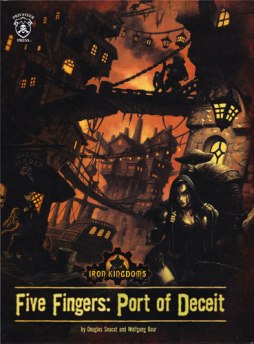 BG: For all those gamers out there who still play Iron Kingdoms, is there anything you’d like to say to them
BG: For all those gamers out there who still play Iron Kingdoms, is there anything you’d like to say to them
MW: Definitely. For all the Iron Kingdoms players out there, I’d like to tell them that we plan to deliver. If they liked what we did before, then they’re going to love what we do next.
Don’t be dissuaded by the notion that we’re using the miniatures games as a foundation for the new RPG system. I know some people absolutely love that, but I can imagine that for others, particularly fans of the d20 system, it might be something that raises an eyebrow. We’re not taking the minis game and trying to repackage it as an RPG. But we’ve got a tried and true conflict resolution system in the minis games, as well as the fundamental mechanics of a working magic system that supports the concepts that are unique to the Iron Kingdoms, so it only makes sense to build on this for the RPG. Designing the RPG will require many additional layers of complexity in order to give all the tools needed for character creation and advancement, as well as the framework to do all the things in an RPG that you can’t do in the minis games. And we’re working hard on some innovative ways in which we’ll make the IK RPG experience original and unique mechanically as well; things we hope will make jumping into an adventure quick and fun, while also giving the depth RPG players want to get out of their gaming.
Despite numerous awards and acclaim for our past RPG products, developing the IK RPG has always been a bit of a rough time for us. It always felt like we were using someone else’s tools, which essentially we were. By creating a proprietary system with which we’ll explore the setting, we have control over every nuance and will avoid the feeling that we’re trying to shove a square peg through a round hole that we ran up against every once in a while under the old system. D20 gave us the ability to jump right in and get going very quickly, and I’m eternally grateful for that. Privateer Press wouldn’t exist right now if it wasn’t for the d20 phenomenon and our love of Dungeons & Dragons. But certain concepts, like warcasters, were impossible for us to express simply and accurately under the constraints of the d20 system, and despite our best efforts, it never felt like we got it just right.
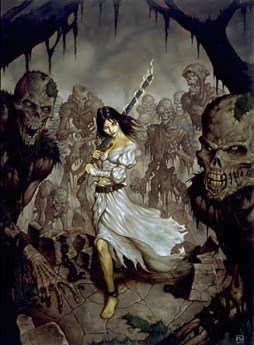 With the new RPG, we’re going to be pulling out all the stops so that players can completely immerse themselves in the Iron Kingdoms. We’re going to give it the same kind of treatment we give all our products now, and being a much more capable company than we were when we started 10 years ago, I think that means a lot of exciting things are in store for IK players.
With the new RPG, we’re going to be pulling out all the stops so that players can completely immerse themselves in the Iron Kingdoms. We’re going to give it the same kind of treatment we give all our products now, and being a much more capable company than we were when we started 10 years ago, I think that means a lot of exciting things are in store for IK players.
So for all those who have adventured in the Iron Kingdoms and long for more Full Metal Fantasy experiences, thank you for keeping hope alive. We aim to deliver the best RPG products we can and to make the long gap in new material worth the wait. 2012 is just around the corner, so sleep with one eye open and keep your powder dry…
There you have it, a fantastic interview with a creative person unlike any other I’ve had the pleasure to meet. I hope you enjoyed reading it as much as I enjoyed collecting these words. Stay tuned for more interviews this summer as John keeps me busy on assignment!
damn i love your posts scott
[…] Black Gate (Scott Taylor) interviews Matthew D. Wilson. […]
Glenn: Thanks for the kind words! It makes doing this well worth the while 😉
[…] Steampunk got its start as hard science fiction, as described at the recent “Founders of Steampunk” panel from the World Fantasy Convention, but it’s definitely moved beyond that. In fact, my first writing for this magazine, back in Black Gate 10, was a review of the fantasy steam-fueled roleplaying game, Iron Kingdoms, in which powerful wizards are able to control hulking mechanized constructs called warjacks. (Interested? Check out this interview with Iron Kingdoms artist Matthew D. Wilson.) […]